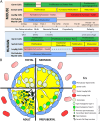How does chemotherapy treatment damage the prepubertal testis?
- PMID: 30394705
- PMCID: PMC6347281
- DOI: 10.1530/REP-18-0221
How does chemotherapy treatment damage the prepubertal testis?
Abstract
Chemotherapy treatment is a mainstay of anticancer regimens, significantly contributing to the recent increase in childhood cancer survival rates. Conventional cancer therapy targets not only malignant but also healthy cells resulting in side effects including infertility. For prepubertal boys, there are currently no fertility preservation strategies in use, although several potential methods are under investigation. Most of the current knowledge in relation to prepubertal gonadotoxicity has been deduced from adult studies; however, the prepubertal testis is relatively quiescent in comparison to the adult. This review provides an overview of research to date in humans and animals describing chemotherapy-induced prepubertal gonadotoxicity, focusing on direct gonadal damage. Testicular damage is dependent upon the agent, dosage, administration schedule and age/pubertal status at time of treatment. The chemotherapy agents investigated so far target the germ cell population activating apoptotic pathways and may also impair Sertoli cell function. Due to use of combined chemotherapy agents for patients, the impact of individual drugs is hard to define, however, use of in vivo and in vitro animal models can overcome this problem. Furthering our understanding of how chemotherapy agents target the prepubertal testis will provide clarity to patients on the gonadotoxicity of different drugs and aid in the development of cytoprotective agents.
Conflict of interest statement
Norah Spears is a member of the Editorial Board of
Figures


References
-
- Anderson RA, Mitchell RT, Kelsey TW, Spears N, Telfer EE, Wallace WHB. 2015. Cancer treatment and gonadal function: experimental and established strategies for fertility preservation in children and young adults. Lancet Diabetes and Endocrinology 8587 1–12. (10.1016/S2213-8587(15)00039-X) - DOI - PubMed

